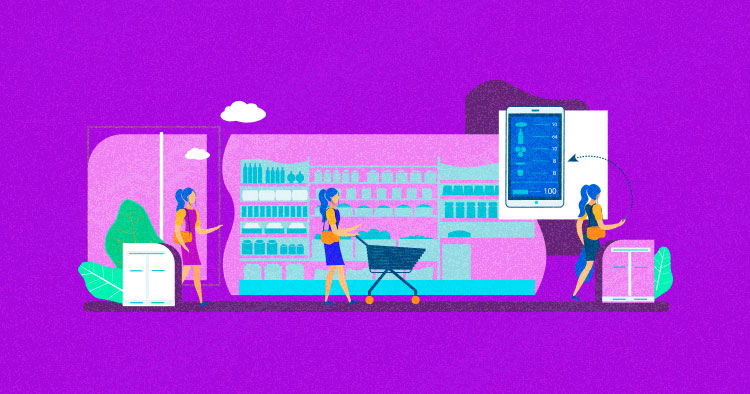
Over the last five to seven years, the ecommerce industry has been at the forefront of growth and innovation and there’s no doubt that the future of ecommerce looks extremely bright. According to Statista, global retail ecommerce sales are expected to grow to $5.4 trillion by 2022. More and more people will also be using artificial intelligence tools for ecommerce to boost conversions.
The coronavirus outbreak has also been a major contributor to sky-rocketing ecommerce growth rates. In 2020 alone, global ecommerce rates grew up to 25.7%, which can be the largest increase between the years 2019 to 2024.
These numbers clearly establish the fact that the ecommerce industry is thriving and has been growing for a while. In fact, it is also one of the most dynamic industries with ever-changing trends, new ecommerce agencies, technological discoveries, and integrations. This is the main reason why the ecommerce industry holds so much potential and is one of the most exciting industries to work in.
- 10 Trends for the Future of Ecommerce in 2022
- ‘New Normal’ in Ecommerce
- Automated Shipping for Speedy Delivery
- Synchronized Physical and Digital Connection
- More Convenient Payment Methods
- Surge in Mobile Ecommerce and Increased Sales
- Personalized Communication and Customer Service Through AI and Chatbots
- Search Through Visual Stimuli
- Alignment of Goals with Social Initiatives
- Machine Learning Taking Customer Experience to A Whole New Level
- The Impact of Apple iOS14 and iOS15 Updates in the Long Term
- Future of Ecommerce: Trends That Ecommerce Business Owners Are Looking Out for in 2022 – 2023
10 Trends for the Future of Ecommerce in 2022
Since a lot of things are expected to change in this industry over the coming years, let’s talk about some of the most exciting ecommerce trends that we’re looking forward to in the future. We believe that these trends will result in even faster growth of the industry and will bring about some impactful changes.
1. ‘New Normal’ in Ecommerce
The coronavirus has made an immense contribution to the sudden growth of the ecommerce industry. When COVID19 was first declared as a global pandemic, people started stocking up. The panic-buying behavior of the masses meant they wanted to get their hands on things as fast as possible. As store supplies started to run out, ecommerce transactions went up because people desperately needed alternatives.

This is further reinforced by a survey done by Search Engine Land which showed that consumers are spending 30% more online. With such reliance on ecommerce, online stores and businesses are also continually evolving. From partnering with better ecommerce hosting providers to working on more convenient online store experiences, there’s a lot that we can expect from the future of e-business.
2. Automated Shipping for Speedy Delivery
When we talk about the future of ecommerce, the potential of automated shipping cannot be ignored. As more customers buy online, the need to open strategically located fulfillment centers has been significantly increasing to deliver orders in the shortest amount of time.
Automated shipping is definitely one of the most important ecommerce future trends that you should look out for and aim to optimize your store with. Not only will this take away the worrisome task of aligning shipments, it will also result in faster and timely deliveries to your customers.

Many shipping automation software like ShipperHQ, ShippingEasy, and Shippo are now widely available to be purchased and integrated directly with your ecommerce stores. There has never been so much competition on fast delivery times before, but using these automated shipping software, you can now lead your competitors.
3. Synchronized Physical and Digital Connection
Synchronizing your brick and mortar store with your digital store is also one of the up and coming ecommerce future trends. There’s no denying the fact that online sales are increasing faster than ever. But that doesn’t mean that brick and mortar stores are losing their value.
If you have a physical and an online store, you can hop on this synchronization trend where you offer the same products, but different experiences to your customers. For example, Nike has completely transformed the in-store experience for its customers. Customers now can customize products, participate in in-store activities and try-out exclusive products, all things that are not possible on a digital space.
Moreover, ecommerce-friendly PoS systems like Lightspeed, Square, and Revel are also becoming increasingly popular which allows you to seamlessly integrate your online store with your physical in-store PoS systems.

If you create two different experiences for your customers online and at your physical shop, you will ensure great ecommerce future growth. In addition, you will be able to gauge old and new customers alike and offer them something unique.
4. More Convenient Payment Methods
With ever-growing global digitalization, it is only fair that new and more convenient ways of making payments are emerging. Ecommerce stores have also come a long way from only offering credit/debit cards, bank transfers or cash payments.
With so many new payment gateways in the market like PayPal, Stripe and 2Checkout, ecommerce business owners can now integrate these payment gateways into their platforms, providing their customers the ease and convenience of making payments in a matter of seconds.

New and convenient payment methods are one of the hottest ecommerce future trends. If you’re an ecommerce business owner, we’d suggest you follow this trend closely and give your customers the best and easiest ways to make payments online.
5. Surge in Mobile Ecommerce and Increased Sales
When it comes to the future of ecommerce, mobile usage is a trend that has been significantly increasing every year. According to Statista, the mobile ecommerce sales share in total ecommerce sales has increased from 52.4% in 2016 to 72.9% in 2021.

This surge in mobile ecommerce can be attributed to the convenience of making purchases from mobile devices. All major ecommerce platforms now have an application, which saves time, and also offers exclusive offers to customers. Moreover, with seamless payment gateway integrations, making payments for your purchased products has also become easier than ever.
However, there is still some ground that needs to be covered. Some customers believe their experiences could be improved if the pages and links weren’t so small to click on. Another concern for these customers is the lack of information and product reviews available on some online platforms. These areas of improvement make mobile ecommerce one of the hottest ecommerce future trends that companies could really work on.
Want to start your online ecommerce store?
Try Cloudways for faster performance, managed security, and 24/7 support.
6. Personalized Communication and Customer Service Through AI and Chatbots
According to a Gartner survey, AI and machine learning will handle 40% of all customer interactions by the year 2023. This means that the future of ecommerce holds a lot of room for growth when it comes to AI and chatbots.
More and more ecommerce businesses are starting to incorporate chatbots into their online stores because of the convenience they offer to the customers as well as the businesses. According to Juniper Research, chatbots will save 2.5bn hours for customers as well as businesses by 2023.

Although AI is still in its early stages, it has seen a lot of progression over the last few years and this trend will continue to grow further especially in the ecommerce industry as the AI technology continues to adapt and evolve.
7. Search Through Visual Stimuli
Visual lookup is a feature that will contribute a lot in the ecommerce future growth and in the buying convenience for customers. Applications like Google Lens or the Image Search feature in Google allow you to identify products you see around you, using its picture. For example, you’re walking around a park and you see a flower that you want to purchase. Take a picture, and search for the flower on the internet using visual lookup. Now you can locate a store nearby and buy the flower.

Searching through visual stimuli is a trend that is still in its developmental stages and there’s room for a lot of refinement. As time passes, this feature is also becoming increasingly popular. With the release of the new iOS15, visual lookup can now be used on your iPhones as well. If Apple and Android developers continue to improve this feature, then there’s no doubt that soon a large amount of people will be using this feature for their day to day online shopping.
8. Alignment of Goals with Social Initiatives
People all over the world are becoming increasingly aware of their individual impact on the planet and how they can contribute in its minimization. Therefore, many ecommerce businesses are now aligning their goals with social initiatives. Not only is this practice great for their ecommerce future, but it’s also needed due to the environmental threats our planet is facing.
Customers today don’t just buy a product, they also look for the social contribution they can make from their purchases. Many companies like Apple, Nestle etc. are working hard to minimize their impact on the environment by reducing the use of plastic in their products.

The general sense of awareness amongst customers coupled with these initiatives will definitely make the future of ecommerce brighter and more importantly, the future of our planet, a whole lot better.
9. Machine Learning Taking Customer Experience to A Whole New Level
The introduction of AI and machine learning is here to revolutionize the future of ecommerce. Ecommerce stores are now incorporating machine learning technology on their websites to enhance their customers’ experiences.
Machine learning is starting to play a major role in the ecommerce industry. With this technology businesses can now show product recommendations based on customer’s buying behavior and the pages they visit. Moreover, AI and machine learning is also helping in giving customers a visual experience of the product in the form of 3D models, online tours, etc.

When it comes to the future of e-business, it’s safe to say that the use of machine learning to enhance online customer experiences will become one of the hottest ecommerce trends, one that ecommerce businesses will greatly benefit from.
10. The Impact of Apple iOS14 and iOS15 Updates in the Long Term
Believe it or not, but things as small as an iOS update can impact global ecommerce trends at some level. As of 2020, there are over 1 billion Apple device users all over the world. That number is enough to make a change in an industry’s dynamics.
With each new iOS, Apple tries to strengthen their privacy measures and give its users more control of the information that is being shared with third-parties and applications. These updates can have a great impact on the future of ecommerce.
In iOS 14, Apple introduced a new privacy feature which gave users the option to choose the amount of information they would like to share with applications. This means that many ecommerce businesses who have apps and use data from those apps for marketing, might not have access to key customer insights.

These privacy-related updates harm ecommerce businesses at some level because they’re losing control of the information they can extract from their applications, in order to tailor their marketing campaigns.
Nevertheless, it’s not all bad when it comes to these updates. New updates have also resulted in better Apple Pay integrations, faster load-time for applications and an overall, more convenient and faster ecommerce shopping experience.
Future of Ecommerce: Trends That Ecommerce Business Owners Are Looking Out for in 2022 – 2023
In this section we will be quoting some ecommerce business owners who have identified some amazing ecommerce future trends that they are looking out for and will be optimizing their online stores for in the next few years to come.
1. ADA Compliant Ecommerce Websites
 Yungi Chu – Owner of HeadsetPlus.com
Yungi Chu – Owner of HeadsetPlus.com
“For 20 years we’ve been in the web business, I had no idea that our ecommerce website needed to be ADA compliant. I only thought ADA laws only applied to stores, malls, restaurants with a physical location. My lawyer informed me that an on-line store (a website) also needs to be ADA friendly for the disable community (such as a visual impaired person), such as size of the font, color, captions, text alternatives to non-text content, etc. The standard is called the WCAG (Web Content Accessibility Guidelines). We expect to be ADA compliant in 2022 as our programmers are working hard to be ADA WCAG compliant with the law.”
2. Visual User-Generated Content
 Brian Dean – Founder of Exploding Topics
Brian Dean – Founder of Exploding Topics
“We all are aware of the fact that user-generated content, such as reviews, can help you gain ecommerce customers’ trust. You’ve almost certainly put reviews on your product pages to increase conversions. However, you might take it a step further and incorporate user-generated visuals into your ecommerce marketing strategy.
Visual user-generated content is becoming increasingly popular in ecommerce marketing, owing to its attractiveness to customers and ability to deliver better outcomes than written content. This is due to the fact that everyone can see how your customers interact with your brand.
You can use user-generated pictures on your product landing pages or on your social media for ecommerce marketing if you want to follow this ecommerce marketing trend.
But how do you collect UGC? As a digital marketing expert, I would advise you to feature customer-submitted images on your product pages. Encourage your consumers to post pictures of their purchases on social media and use a branded hashtag.. After that, you can collect the images and post them on social media. On the relevant product pages, you could also showcase some of the best user-submitted photos.”
3. Voice Shopping on Online Stores
 Darshan Somashekar – Founder & CEO at Spider Solitaire Challenge
Darshan Somashekar – Founder & CEO at Spider Solitaire Challenge
“Well, in our company, we plan to implement voice search to optimize our stores for the upcoming year. By 2022, the global voice assistant speaker market will be worth around $4 billion, and voice purchasing will be worth $40 billion. Aside from that, by 2022, 55% of US homeowners will own a smart speaker. As a result, ecommerce businesses will employ voice search optimization techniques to reach prospects during voice search purchasing. The key to voice web optimization is rich reply optimization and long-tail conversational key phrase optimization. Using a key phrase analysis device that leverages data to discover the most recent trends will be a great resource for determining similar voice search key phrases.”
4. Virtual and Augmented Reality
 Ben Hartwig – Web Operations Executive at InfoTracer
Ben Hartwig – Web Operations Executive at InfoTracer
“Ecommerce has been rapidly rising to become the main source of revenue for almost all businesses in all industries, especially after the pandemic integrated the importance of our online presence. This is shown in the 31.73% growth in ecommerce between 2019 and 2020, compared to 14.12% the previous year.
Hence, businesses must focus on optimizing their online side, and focusing on trends that accompany ecommerce thanks to the rapid, non-stop technological advances. Of these trends, virtual/augmented reality experiences are the ones people should keep an eye and focus on for the coming years, especially with expectations of VR being regularly used by 25% of internet users (70.2 million) by 2023.
Shoppers are now used to having an in-store experience but with VR/AR, they can actually visualize how a product looks in real life from different angles and sides instead of just looking at an image. This will benefit businesses in increasing sales where this technology allows consumers to be fully convinced and actually purchase products. Examples can range from trying on a shirt, to bed linens and sheets, and makeup that you can “try on yourself online”.
VR/AR also has the potential to enhance customer relationships where now store representatives can have fully immersive tours with their clients, all from the comfort of their homes, offices, and anywhere else.
This does come at a small price where businesses should be conscious about cyber threats and enhance their online security.”
5. Progressive Web Applications (PWAs)
 Alex Husar – Chief Technology Officer at Onilab
Alex Husar – Chief Technology Officer at Onilab
“Onilab isn’t an ecommerce company, but we specialize in ecommerce development and have years of experience in the field. And how do our customers want to optimize their online retail stores?
The main online retail trend of the 2020s is the transition from a monolithic architecture to headless commerce. This includes the creation of progressive web apps as a big step towards website optimization.. But first, what is PWA?
It remains a website but is optimized to be as fast and convenient as a native application. Many ecommerce brands take an active interest in this solution because it provides the following advantages:
- PWAs cost less to develop and support. It’s not like investing in separate Android and iOS native apps with specialized development tools and coding languages. Plus, PWAs work in various browsers, so the store becomes both desktop and mobile-friendly.
- PWAs load in a flash. The solution combines advanced caching, GraphQL (a modern API approach), and other solutions that speed up site performance. This improves user satisfaction and helps to enhance site metrics. Such stores also become available at a low Internet speed or offline.
- Page usability is another factor in ranking. PWAs can provide as seamless and intuitive UX\UI as native apps, improving conversions. And PWAs are accessible for search engines.
- There’s no need to submit a PWA to the app stores as it’s launched in browsers. Also, a PWA doesn’t take up as much device memory as native apps do. If smartphone users want to save the app’s shortcut, they can go to the browser settings, tap the “Add to Home Screen” button, and enjoy the experience. That’s how it happens with the example of Apivita’s PWA.

- Online store owners make use of push notifications as a part of their customer retention strategy. It’s generally associated with native apps, but PWAs also support this feature.
All things considered, I’d like to say that PWAs are one of the promising ecommerce trends in 2022-2023 and beyond.”
Wrapping Up
There is no doubt that the future of ecommerce is going to be exciting and filled with mind-blowing, new technological advancements and innovations.
If you’re a part of the ecommerce industry, keep an eye out for these ecommerce future trends and be amongst the first ones to try out something new on your online store. Keep yourself updated with all the new technologies, talk to industry influencers, share ideas and get as much knowledge as possible. That is how you’ll stay ahead of your competitors and continue to grow in this vast, thriving industry.
Q1. What are some important store-related functions that I can automate?
You can automate several important tasks like, sending out emails, contacting prospects, aligning supply chain, and warehouse management.
Q2. What is Mobile Commerce?
Mobile commerce, also known as m-commerce or mcommerce refers to the use of mobile phones and tablets for online buying and selling on ecommerce platforms.
Q3. What are the hottest trends for the future of ecommerce?
Some popular trends that you should be keeping an eye out for are, AR and VR, voice search, and chatbots.
Shoaib Israr
Shoaib is a passionate digital marketer who believes creativity is everything. His interests lie in content, digital marketing and he loves to help agency and ecommerce business owners in growing and expanding their businesses. In his free time, Shoaib loves to play football or binge-watch some interesting shows on Netflix.


